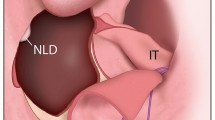Abstract
Objective
The aim of the study is to evaluate the usage of Dieffenbach’s modification of Weber–Fergusons approach in the treatment of lesions involving maxilla.
Study
In this study five different maxillary pathologies were approached through Dieffenbach’s modification of Weber–Fergusons approach. Partial and subtotal procedures were performed depending on the type of pathology and the extent of the lesion which was assessed both clinically and radiologically. The study evaluates the easy exposure of the site, post operative complications like scar formation and infra orbital nerve parasthesia.
Results
There were two subtotal maxillectomy procedures and three partial maxillectomy procedures approached through Dieffenbach’s modification of Weber–Fergusson’s approach. All the cases recovered well in the post operative healing period without noticeable scarring. There was parasthesia in three cases which subsided in 3 months.
Conclusion
The approach through Dieffenbach’s modification of Weber–Fergusons incision gave better visibility and accessibility to the lesions of maxilla. Because there is direct access to the pathology, the inadvertent resection of the un-involved structures is prevented thus minimizing the morbidity.




Similar content being viewed by others
References
Chiodo AA, Strumas N, Gilbert RW, Birt BD (1997) Management of odontogenic myxoma of the maxilla. Otolaryngol Head Neck Surg 117(6):S93–S96
Zaghloul AS, Nouh MA, Fatah HA (2004) Midfacial degloving approach for malignant maxillary tumors. J Egypt Natl Canc Inst 16(2):69–75
Fernandes R, Ord R (2006) Access surgery for oral cancer. Oral Maxillofac Surg Clin North Am 18:565–571
Hayter JP, Vaughan ED, Brown JS (1996) Aesthetic lip splits. Br J Oral Maxillofac Surg 34:432–435
Carol R. Bradford and Mark E. Prince (2004) ACS Surgery, principles & Practice, Head and neck, Oral cavity procedures
Rai A, Bhola N, Datarkar A, Borle R (2010) Modified Weber–Fergusson incision with Borle’s extension. Br J Oral Maxillofac Surg 48:e23–e24
Andi KA, Holmes SB, Hutchison IL (2010) Infraorbital orbitotomy: modification of the Weber–Ferguson approach. Br J Oral Maxillofac Surg 48:44–45
Kademani D (2007) Le Fort maxillary swing procedure for posterior maxilla tumor extirpation. J Oral Maxillofac Surg 65:1055–1058
Pai SB, Harish K, Venkatesh MS, Udayshankar, Jermely D (2005) Ethmoidal osteoid osteoma with orbital and intracranial extension—a case report. BMC Ear Nose Throat Disord 5(2):1–6
Saha S, Saha VP, Chattopadhyay S (2002) Orbital and para orbital tumors–clinicopathological profile and surgical management. Indian J Otolaryngol Head Neck Surg 54(2):117–122
Hassan S, Abdullah J, Abdullah B, Shah Jihan WD, Jaafar H, Abdullah S (2007) Appraisal of clinical profile and management of juvenile nasopharyngeal angiofibroma in Malaysia. Malays J Med Sci 14(1):18–24
Honda K, Asato R, Tanaka S, Endo T, Nishimura K, Ito J (2008) Vidian nerve schwannoma with middle cranial fossa extension resected via a maxillary swing approach. Head Neck 30(10):1389–1393
Nair S, Sridhar KR, Shah A, Kumar B, Nayak K, Shetty P (2011) Maxillectomy through mandibulotomy—a retrospective clinical review. J Oral Maxillofac Surg 69(7):2040–2047
Gauglitz GG, Korting HC, Pavicic T, Ruzicka T, Jeschke MG (2011) Hypertrophic scarring and keloids: pathomechanisms and current and emerging treatment strategies. Mol Med 17(1–2):113–125
Umeda M, Minamikaw T, Komatsubara H, Ojima Y, Shibuya Y, Yokoo S, Komori T (2005) En bloc resection of the primary tumour and cervical lymph nodes through the parapharyngeal space in patients with squamous cell carcinoma of the maxilla: a preliminary study. Br J Oral Maxillofac Surg 43:17–22
Author information
Authors and Affiliations
Corresponding author
Rights and permissions
About this article
Cite this article
Rajasekhar, G., Vura, N.G., Sudhir, R. et al. Versatility of Dieffenbach’s Modification of Weber Fergusson’s Approach for Treatment of Maxillary Pathologies. J. Maxillofac. Oral Surg. 11, 416–419 (2012). https://doi.org/10.1007/s12663-011-0331-9
Received:
Accepted:
Published:
Issue Date:
DOI: https://doi.org/10.1007/s12663-011-0331-9




